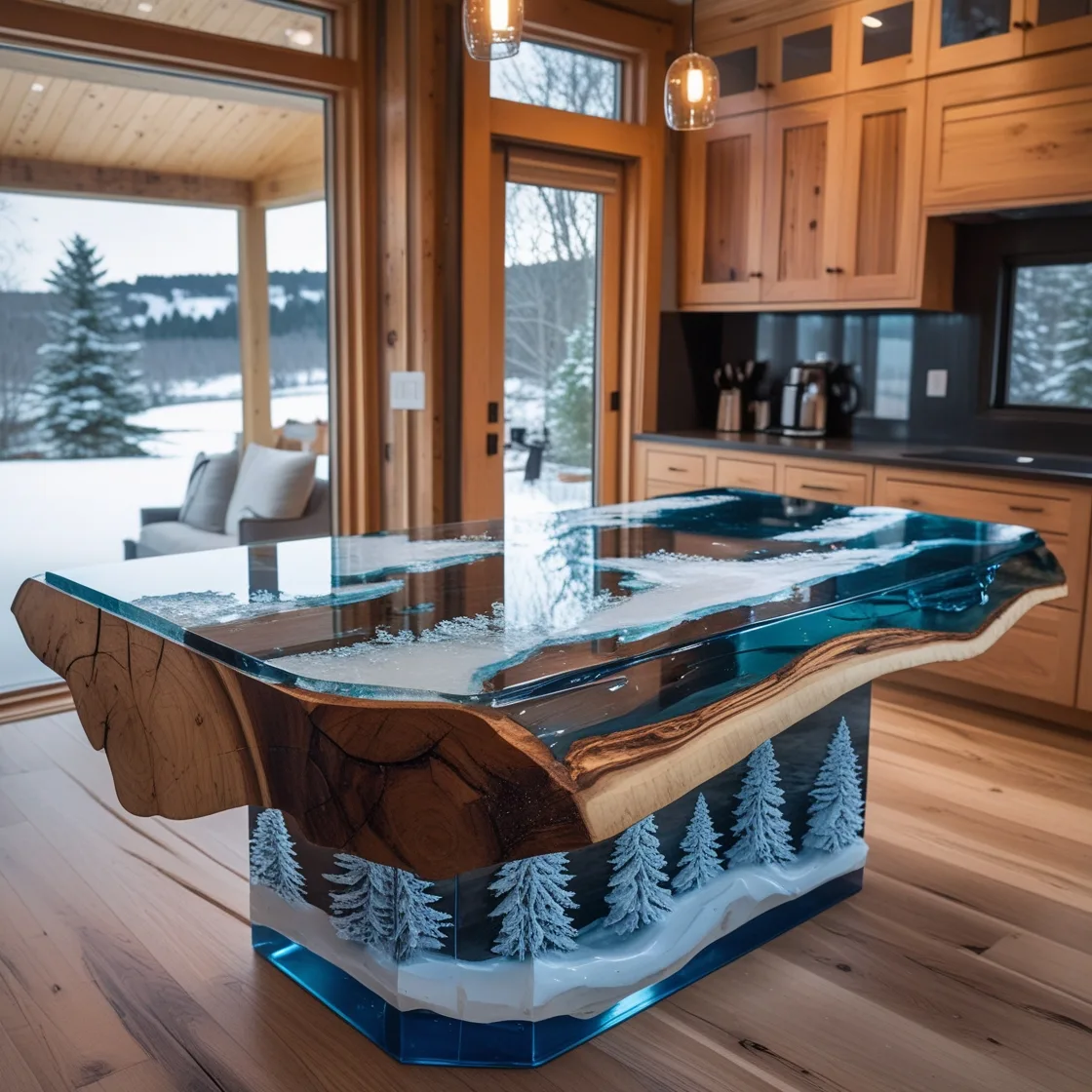When it comes to kitchen design, there’s a growing trend that merges natural beauty with modern innovation: resin and wood kitchen islands. This striking combination of materials brings a unique aesthetic appeal to your kitchen, blending the organic warmth of wood with the sleek, glossy finish of resin. Whether you’re renovating your kitchen or building a new one, a resin and wood kitchen island can serve as both a practical workspace and a stunning centerpiece.
In this blog post, we’ll explore the many benefits of choosing a resin and wood kitchen island, discuss the design possibilities, and offer tips on how to care for and maintain this beautiful piece of furniture. Let’s dive into why this blend of materials is becoming a favorite for homeowners and designers alike.
What is a Resin and Wood Kitchen Island?
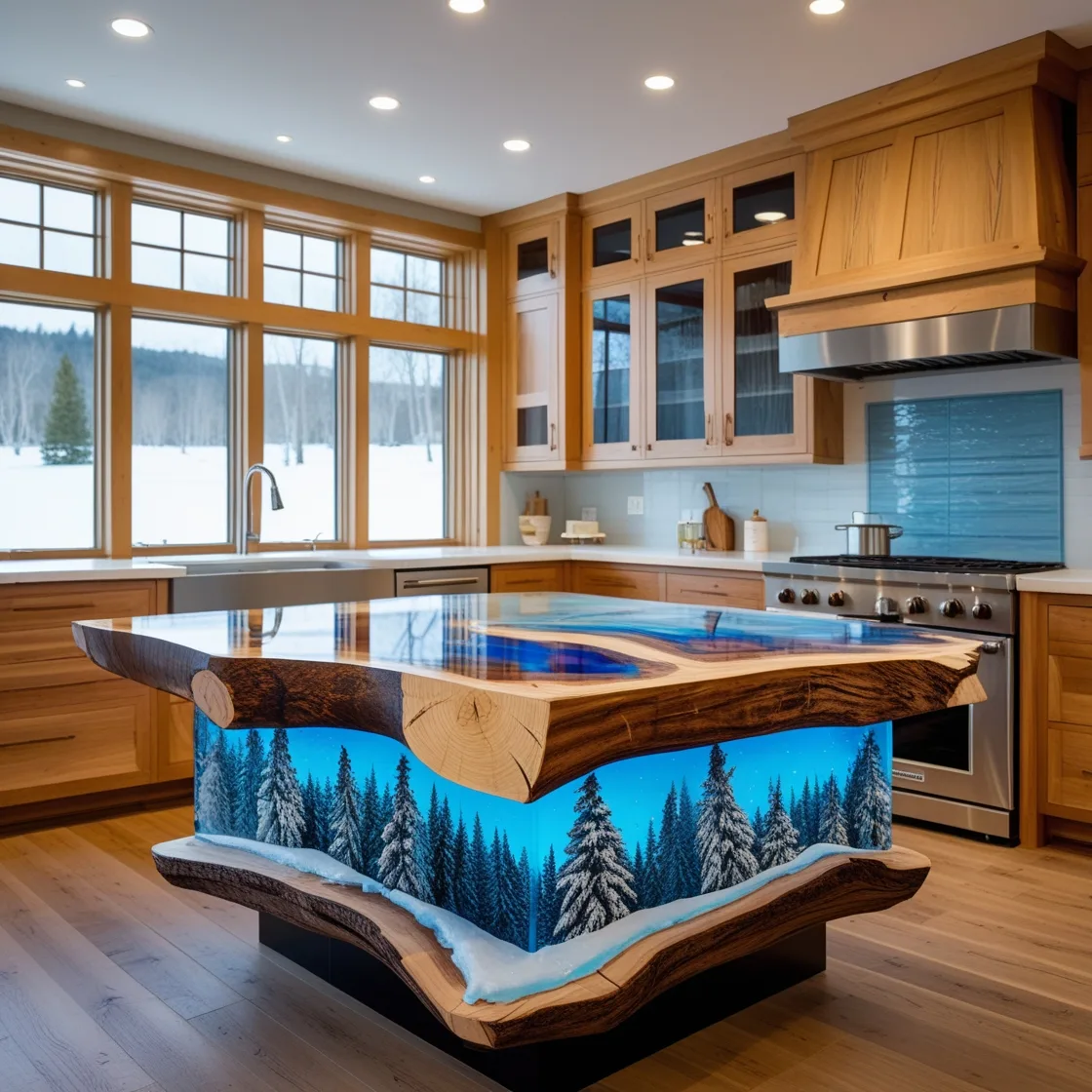
The Resin Material: A Modern Touch to Natural Wood
Resin is a synthetic material that can be molded and shaped to create a smooth, glossy surface. It is often mixed with various pigments, dyes, and even natural elements like wood or stone, giving it a unique appearance. Resin can enhance the natural grain of wood, creating a stunning contrast between the rustic texture of the wood and the polished, reflective surface of the resin.
In a resin and wood kitchen island, the wood provides the sturdy structure, while the resin serves as a protective coating that is also visually striking. This combination of materials allows for incredible versatility, with endless design possibilities that can complement any kitchen style—whether traditional, contemporary, or rustic.
The Wood Element: Classic Elegance
Wood has been a staple in kitchen design for centuries. Its natural beauty, durability, and warmth make it an ideal material for high-traffic areas like the kitchen. Common wood choices for kitchen islands include oak, maple, walnut, and cherry, each offering a distinct look and feel. When paired with resin, the wood’s natural grain is highlighted, and the resin helps preserve the wood while adding a touch of modern flair.
Why Choose a Resin and Wood Kitchen Island?
Durability and Longevity
One of the most significant advantages of a resin and wood kitchen island is its durability. Resin is resistant to stains, scratches, and moisture, which makes it an excellent choice for a kitchen environment. Wood, when properly treated and maintained, is also incredibly durable. Together, these materials form a long-lasting and robust piece of furniture that can withstand the daily wear and tear of kitchen life.
Easy to Clean and Maintain
With a busy kitchen, ease of cleaning is always a priority. The resin coating on the island provides a smooth, non-porous surface that repels dirt and grime. It’s easy to wipe clean, and spills won’t seep into the surface, making it ideal for cooking and meal prep. The wood base also requires minimal maintenance with occasional polishing or oiling to preserve its natural beauty.
Aesthetically Pleasing and Versatile
A resin and wood kitchen island brings an undeniable aesthetic appeal to your kitchen. The glossy finish of resin contrasts beautifully with the rich, natural wood tones, creating an eye-catching feature. The resin can also be tinted in a wide range of colors or infused with elements like crushed stone or metallic flecks, allowing you to customize the design to suit your kitchen’s style.
Whether you prefer a rustic look with live-edge wood, a sleek modern design, or a vibrant pop of color, this combination offers unlimited possibilities. The mix of materials ensures that the island will be both functional and a focal point in your kitchen.
Eco-Friendly Option
Another benefit of choosing a resin and wood kitchen island is that it can be an environmentally friendly option. Many resin products are made from non-toxic materials, and the wood used can often be sourced sustainably. If you are conscious about the environment, this can be an excellent choice that doesn’t sacrifice style or functionality.
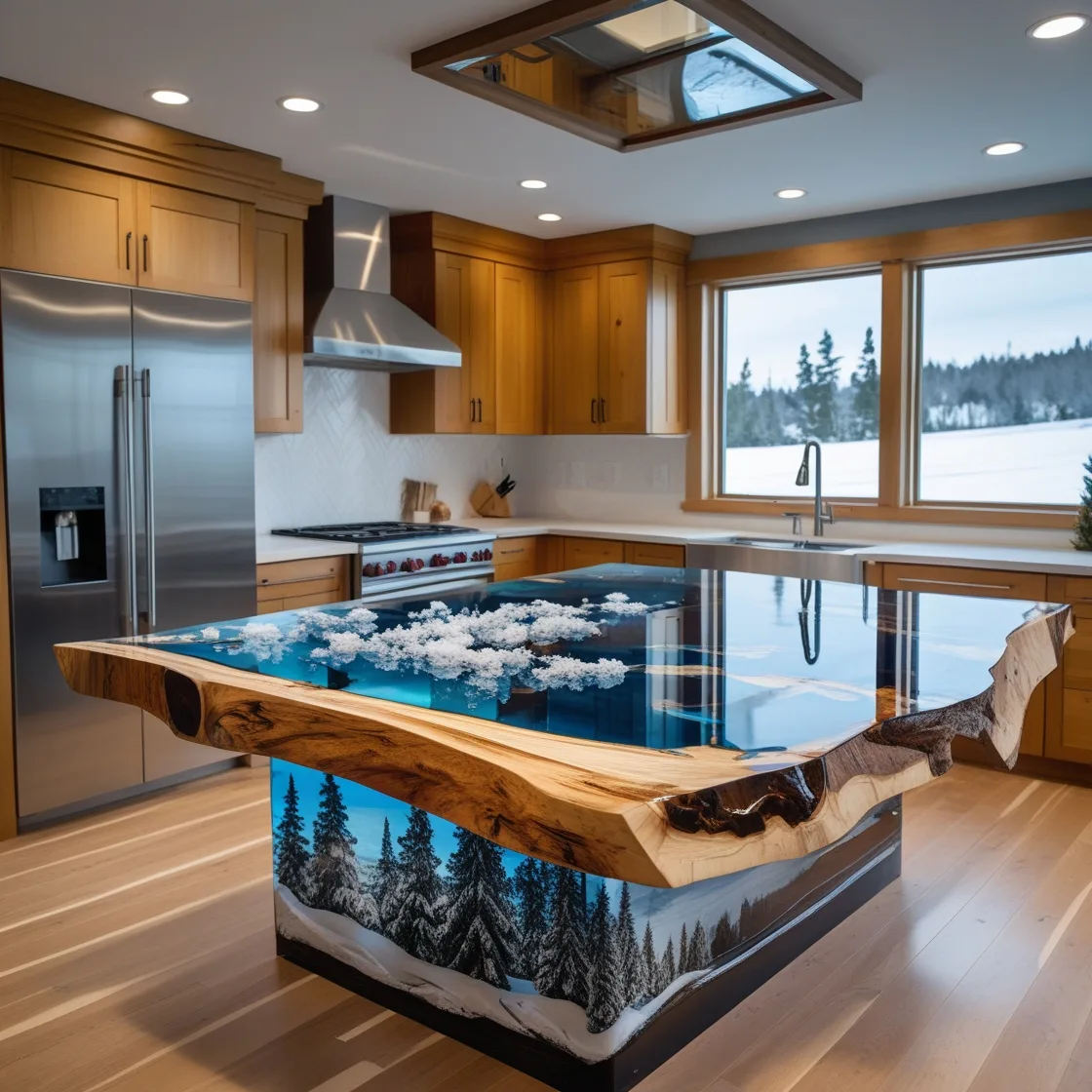
Design Ideas for Your Resin and Wood Kitchen Island
Live Edge Wood with Clear Resin
For a rustic and natural look, consider using live-edge wood as the base for your kitchen island. Live-edge refers to the natural edges of the wood, which retain the organic shape of the tree. When paired with clear resin, the wood’s unique grain patterns and natural beauty are showcased while creating a smooth, sleek surface that’s easy to clean.
Contrasting Colors and Textures
A resin and wood kitchen island doesn’t have to be one solid color. You can create striking contrasts by choosing different wood types and resin colors. For example, a dark walnut wood base with a light-colored resin can create a stunning visual contrast. Alternatively, you could opt for a multi-colored resin to add vibrancy to your kitchen.
Adding Metallic Elements
If you prefer a more modern or industrial look, incorporating metallic elements like gold, silver, or copper into the resin can add sophistication and a touch of luxury. These metallic veins running through the resin create a dazzling effect, especially when the island’s surface catches the light.
Functional Features: Built-In Storage or Seating
In addition to its beauty, a resin and wood kitchen island can be designed for functionality. Consider adding built-in storage, drawers, or open shelving to keep your kitchen organized. You can also design the island with seating for casual dining or entertaining. This ensures your kitchen island serves as both a functional workspace and a place for family and guests to gather.
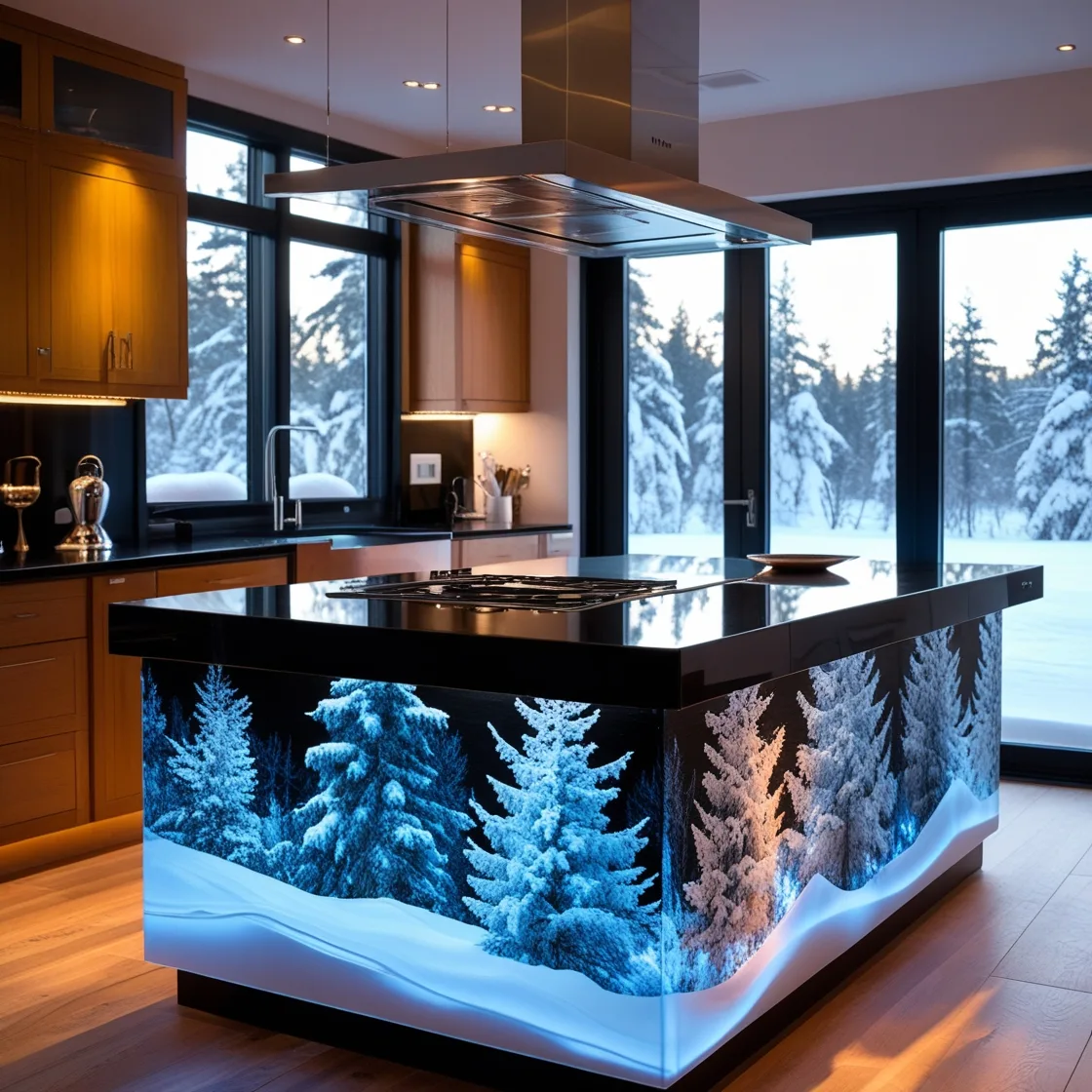
How to Care for Your Resin and Wood Kitchen Island
Regular Cleaning
To keep your resin and wood kitchen island looking its best, regular cleaning is essential. Use a soft cloth and mild soap solution to wipe down the resin surface, avoiding harsh chemicals that could damage the finish. For the wood base, a gentle furniture polish or wood cleaner will help preserve its appearance and protect it from drying out.
Protect the Wood
While resin is durable, the wood beneath it requires some care to maintain its integrity. Periodically apply a wood conditioner or oil to keep the wood nourished and prevent it from cracking or drying out. Be sure to follow the manufacturer’s recommendations for the specific type of wood used.
Avoid Direct Heat
Although resin is resistant to heat, it’s always best to avoid placing hot pots or pans directly on the surface. Use trivets or hot pads to protect the resin from potential damage. The wood may also be sensitive to excessive heat, so it’s a good idea to keep it away from direct exposure.
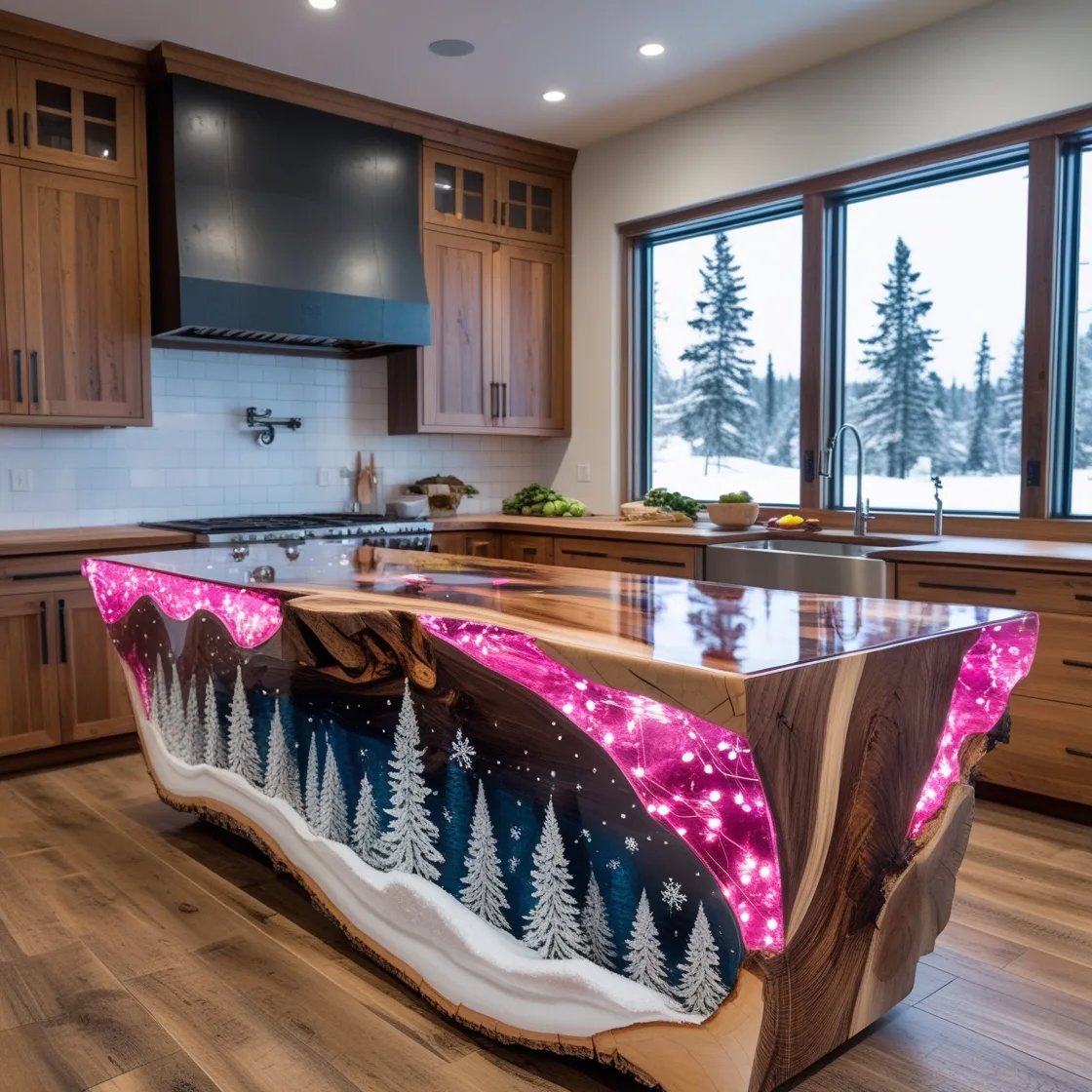
How to Choose the Right Resin and Wood Kitchen Island for Your Home
When selecting a resin and wood kitchen island, it’s important to consider various factors that will ensure it fits perfectly in your space. Here are some key points to keep in mind as you make your decision.
Size and Shape: Finding the Right Fit
Before purchasing a resin and wood kitchen island, measure the available space in your kitchen. Islands come in various sizes, from compact ones perfect for smaller kitchens to large, expansive designs that can serve as the central hub for meal prep, dining, and entertaining. The shape of the island is another factor to consider—whether you prefer a traditional rectangular design, an L-shaped island for more counter space, or a circular or oval shape for a softer, more organic look.
Take into account the layout of your kitchen as well. If you have an open-plan space, a larger island can serve as a visual anchor, while in more compact kitchens, a smaller island may be a better fit. It’s essential that your island doesn’t overcrowd the space or obstruct traffic flow.
Wood Type: Choosing the Right Material for Your Style
The type of wood you choose for your kitchen island plays a significant role in its overall aesthetic. Different wood species offer varying tones, textures, and characteristics that can complement different kitchen styles.
- Oak: Oak is a versatile and durable choice that can work with both traditional and modern designs. Its light, golden tones add warmth and brightness to any space.
- Walnut: If you’re looking for a rich, dark tone, walnut provides a luxurious and sophisticated finish. It pairs beautifully with clear or metallic resin.
- Maple: Maple is a lighter wood that offers a clean, natural look, making it a great option for contemporary kitchen designs.
- Cherry: Cherry wood has a warm, reddish hue that deepens over time, adding depth and character to your island.
Consider the existing color palette of your kitchen and select a wood type that will complement or contrast nicely with other elements like cabinetry, flooring, and countertops.
Resin Color and Texture: Tailoring to Your Aesthetic
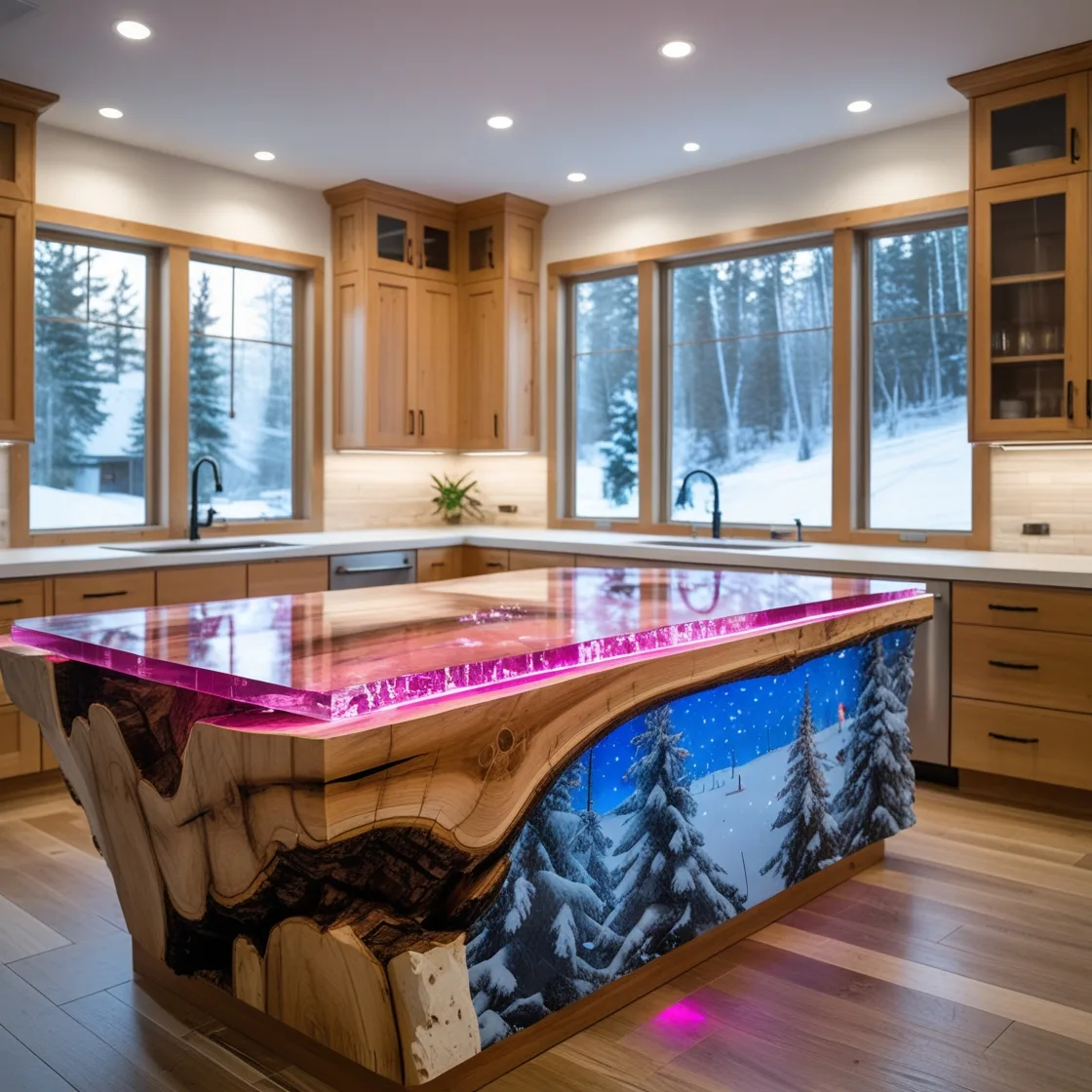
The resin layer provides endless design possibilities. While clear resin is a popular choice because it showcases the natural wood grain beautifully, you can experiment with various colors and finishes to match your personal style.
- Clear Resin: This is the most popular choice for a sleek, modern look. It highlights the wood grain and gives the piece a clean, polished appearance.
- Colored Resin: If you want a more bold or vibrant look, consider colored resins in shades like blue, green, or even deep black. Colored resin can add personality and dimension to your island, turning it into a statement piece.
- Metallic Resin: For a luxurious, contemporary look, metallic resins infused with gold, silver, or copper can create an elegant finish that catches the light and adds sophistication to your kitchen.
- Textured Resin: Some designers opt for textured resin, which can create a more natural, organic feel. This resin might have a marbled or wave-like texture that mimics the movement of water or natural stone.
Choosing the right resin color and texture is crucial in achieving the aesthetic you want for your kitchen island. Whether you prefer a minimalist style or something more artistic and eye-catching, the resin can be tailored to your exact specifications.
The Cost of a Resin and Wood Kitchen Island
While a resin and wood kitchen island offers numerous benefits, it’s important to be aware of the cost factors involved. The price of your island can vary greatly depending on factors like the type of wood, resin, customizations, and size. Here are some points to consider when budgeting for this beautiful kitchen feature.
Material Costs: Wood and Resin Selection
The type of wood you choose will have a significant impact on the overall cost of the island. High-end hardwoods like walnut or cherry are more expensive than options like oak or maple. The resin material is also a cost factor—colored or metallic resins tend to be more expensive than clear resin, especially if you choose custom colors or finishes.
Customization and Design Features
If you’re opting for a custom resin and wood kitchen island, the price can increase depending on the level of customization. Features such as built-in storage, seating, or unique design elements will add to the cost, but they can make the island even more functional and tailored to your needs. Customizations can also include unique resin effects, such as incorporating natural elements like stones, shells, or other materials into the resin for a truly one-of-a-kind look.
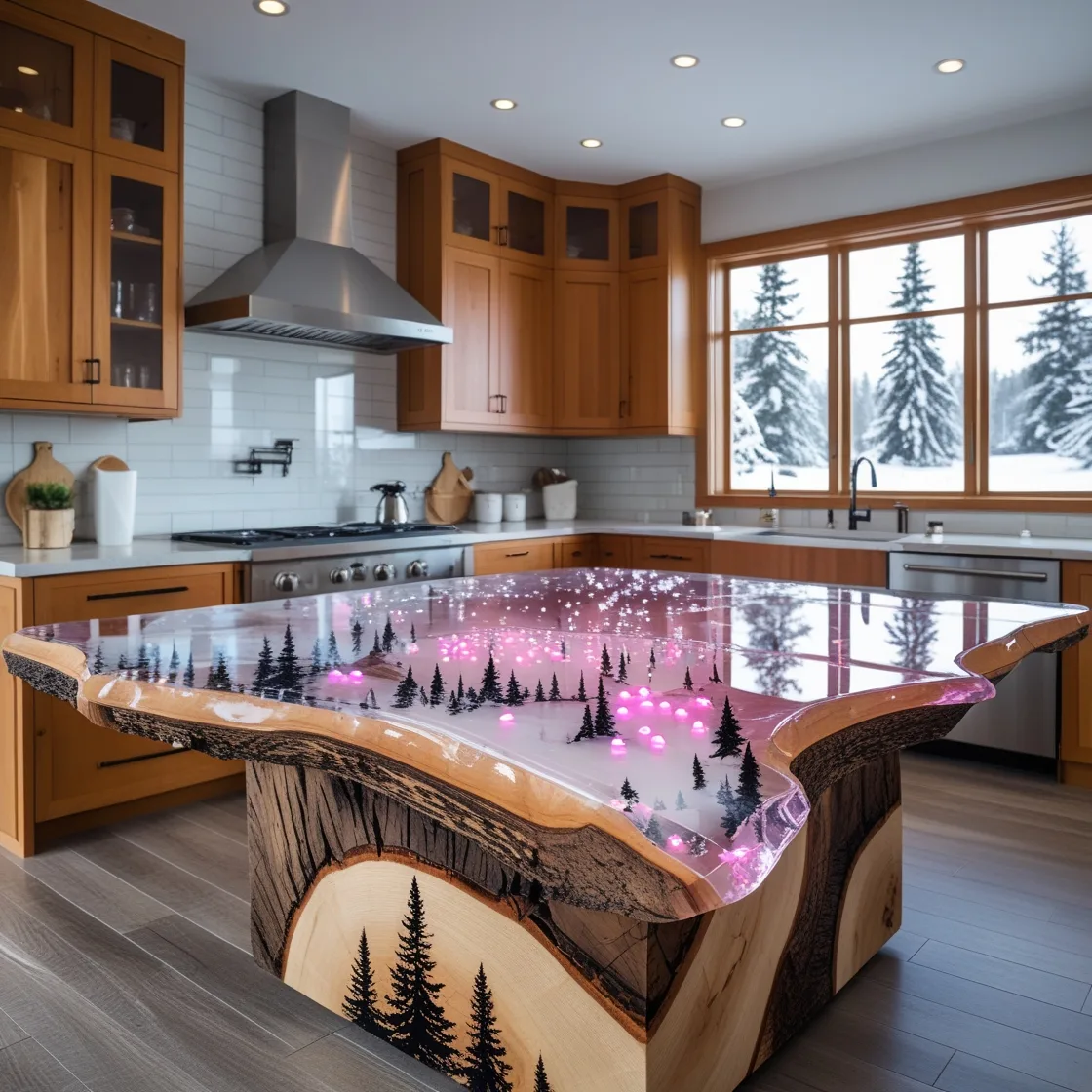
Labor and Installation Costs
When opting for a custom piece, don’t forget to factor in labor and installation costs. The complexity of the design and materials used can impact the cost of the construction process. It’s important to work with a skilled craftsman or company experienced in working with both wood and resin to ensure the final product is of high quality.
Resin and Wood Kitchen Islands in Modern Design Trends
Minimalist and Industrial Styles
In recent years, resin and wood kitchen islands have become a popular choice for both minimalist and industrial interior designs. The simplicity of clean lines combined with the organic beauty of wood and the modern touch of resin fits perfectly into these contemporary design aesthetics. The industrial style benefits from the raw, natural look of wood paired with sleek, shiny resin finishes that add a polished contrast to rougher elements like exposed metal or concrete.
For a minimalist approach, clear resin with a simple wood base works beautifully, offering a streamlined look that doesn’t overwhelm the space.
Coastal and Rustic Kitchens
For those who love rustic or coastal-inspired interiors, a resin and wood kitchen island can tie the room together. The use of live-edge wood or reclaimed wood, coupled with soft, ocean-inspired resin colors like aqua, pale blue, or seafoam green, evokes a tranquil and natural vibe. The island can be a central focal point that brings the outdoors in, perfect for those who appreciate organic, natural beauty in their home décor.
Traditional Elegance with a Twist
Even in traditional kitchens, the resin and wood kitchen island can be incorporated seamlessly. For more classic kitchen designs, you might opt for dark wood finishes like cherry or walnut paired with clear resin or subtle metallic resin. This creates an elegant yet updated look, giving your kitchen a timeless appeal while maintaining a modern edge.
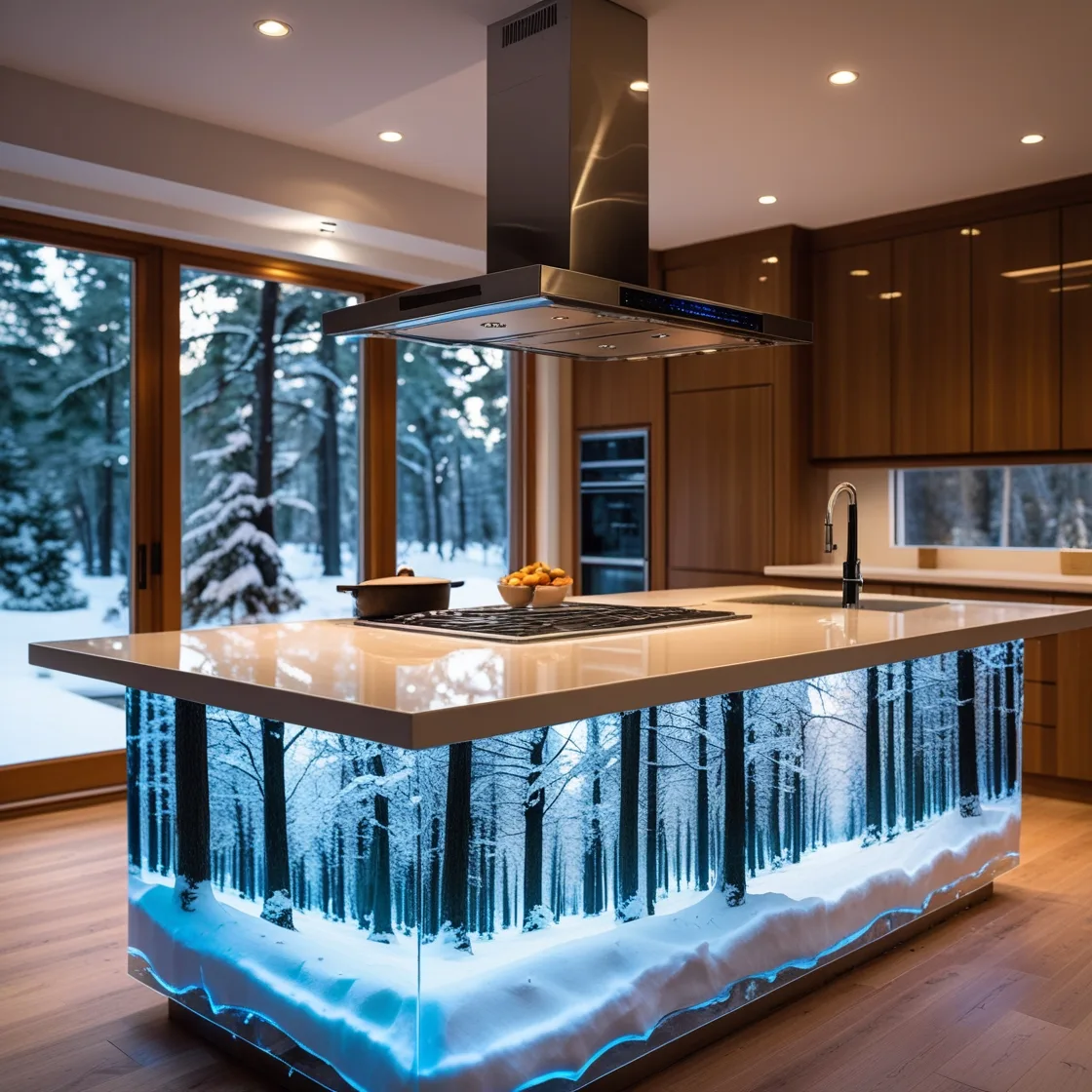
Conclusion: A Lasting Investment in Your Kitchen’s Future
A resin and wood kitchen island is not only an aesthetically pleasing addition to your kitchen, but it also serves as a practical and functional centerpiece that will stand the test of time. With its ability to blend the best of nature and modern innovation, this type of island creates a harmonious balance between beauty and utility.
From offering a durable, easy-to-maintain surface to providing endless design possibilities, a resin and wood kitchen island can elevate your cooking and dining space to new heights. Whether you’re looking for something rustic, modern, or customized to suit your unique style, this combination of materials delivers both visual appeal and functionality.
By carefully selecting the right materials, size, and design, you can create a kitchen island that serves as both a work surface and a conversation piece. So, if you’re ready to transform your kitchen and add a touch of luxury, consider investing in a resin and wood kitchen island that will bring your space to life for years to come.

